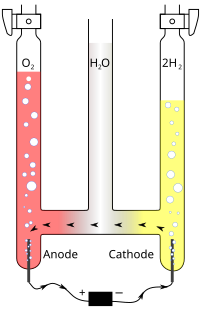
Photo from wikipedia
Abstract Three phosphorus containing molecules, tris(2,2,3,3,3-pentafluoropropyl) phosphate (5F-TPrP), tris(1,1,1,3,3,3-hexafluoropropan-2-yl) phosphate (HFiP) and tris(1,1,1,3,3,3-hexafluoropropan-2-yl) phosphite (THFPP), were investigated as high voltage and flame retardant electrolyte additives for lithium ion batteries. The… Click to show full abstract
Abstract Three phosphorus containing molecules, tris(2,2,3,3,3-pentafluoropropyl) phosphate (5F-TPrP), tris(1,1,1,3,3,3-hexafluoropropan-2-yl) phosphate (HFiP) and tris(1,1,1,3,3,3-hexafluoropropan-2-yl) phosphite (THFPP), were investigated as high voltage and flame retardant electrolyte additives for lithium ion batteries. The effect of the oxidation state of the phosphorus atom as well as the influence of branched vs. linear fluorinated propyl groups were investigated regarding cycling performance and flammability of the resulting electrolyte. In the case of a high voltage battery application, all three investigated molecules showed an improvement regarding the cycling performance in NCM111/Li half-cells. Post mortem analysis of the NCM111 electrodes via SEM and XPS indicates that the different groups of two phosphates (5F-TPrP vs. HFiP) have an impact on the thickness, morphology and composition of the cathode electrolyte interphase (CEI). If the electrolyte formulation contains the linear side group (5F-TPrP), the thickness of the CEI increases, whereas for the branched group (HFiP) it decreases compared to the CEI formed in 1 M LiPF 6 EC:DEC (1:1) used as reference electrolyte. Furthermore, addition of at least 20 wt.% of 5F-TPrP to the reference electrolyte formulation resulted in a non-flammable electrolyte formulation.
Journal Title: Journal of Fluorine Chemistry
Year Published: 2017
Link to full text (if available)
Share on Social Media: Sign Up to like & get
recommendations!